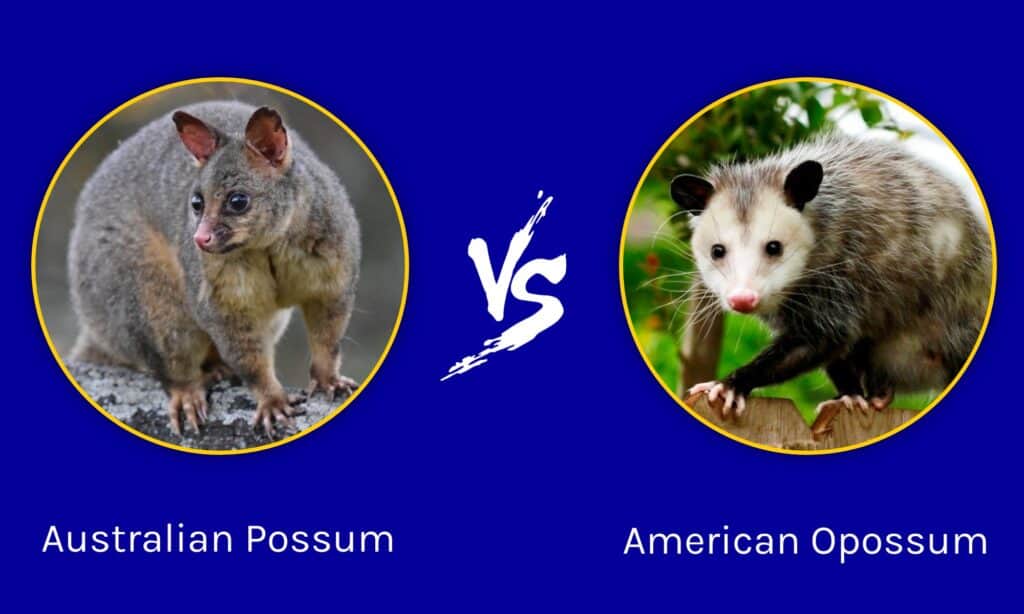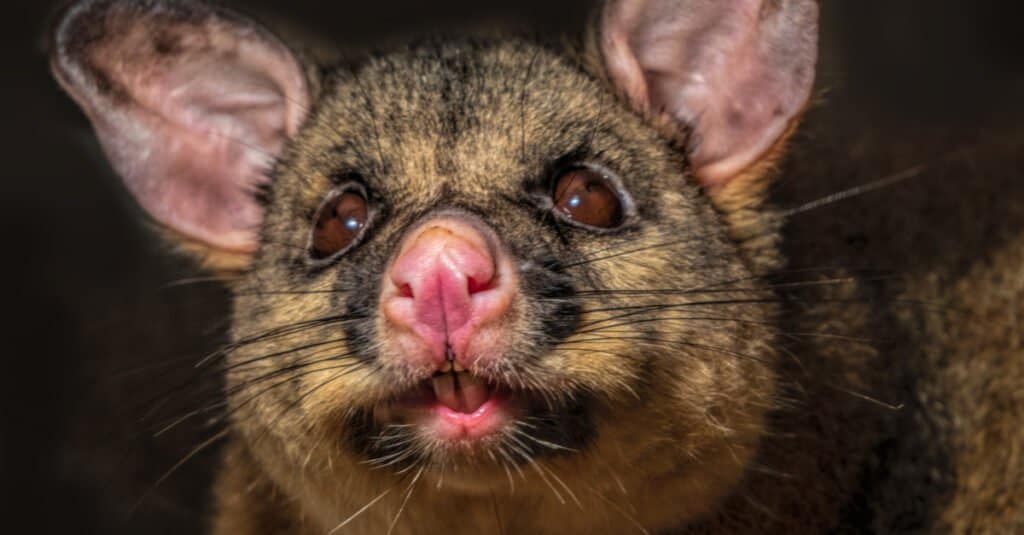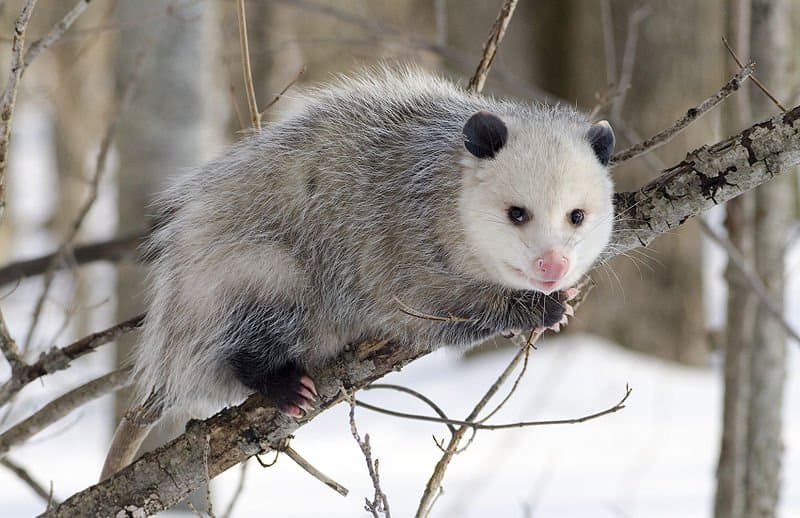Different parts of the world usually have different names for the same thing. However, different parts of the world occasionally have the same name for different things! For Australian possums and American opossums, it’s pretty close. Although these two creatures share some similarities and often go by the same name, they are entirely different animals. Today, let’s explore the difference between an Australian Possum vs American Opossum!
Comparing an Australian possum and an American opossum

| Australian possum | American opossum | |
|---|---|---|
| Name | Members of the Phalangeriformes suborder, referred to as “possums.” | Members of the Didelphimorphia order, referred to as “opossums,” but the “o” is often dropped. |
| Appearance | Large pointed ears, bushy tail, furry body. Often silver, grey, brown, black, red, or cream. | Thin fleshy tail, stark-white face, gray bodies, pink feet. |
| Size | 1-2 feet long, excluding tail. Weighs around 2.6-10 lbs. | 13-37 inches, excluding tail. Weighs around 1.7-14 lbs. |
| Distribution | Australia, Tasmania, New Zealand. | North and Central America. |
| Habitat | Forests, urban areas, and semi-arid regions. | Forested areas. |
| Diet | Mostly vegetation, especially eucalyptus leaves. | Omnivorous scavengers. |
| Special adaptations | Highly adaptable to human environments. | Venom tolerance. Playing dead. |
The 7 main differences between an Australian possum and an American opossum
The main difference between an Australian possum and an American opossum is that possums are native to Australia, are furry and have bushy tails, and eat mostly vegetation. American opossums are native to Central and North America, are gray and white and are omnivorous scavengers.
Both possums and opossums are relatively common creatures in their respective regions. Despite having similar names, both groups belong to different regions of the world and have varying habits and lifestyles. Still, their similarities were enough that the Australian possum was named after the opossum from North America. The most common possum in Australia is the common brushtail possum. The most common (and only) possum in North America is the Virginia opossum, although it is often referred to as an “opossum” or simply “possum.”
Australian possums are fluffy and come in various colors, while the opossum is always gray with a stark white face. Additionally, the Australian possum is usually a bit smaller than its American cousin, although they can be quite close in size depending on the habitat.
Let’s take a closer look at some of the other differences between an Australian possum and an American opossum below.
Australian Possum vs American Opossum: Name

The common brushtail possum is native to Australia and is the second largest of the possums.
©Timothy Christianto/Shutterstock.com
The Australian possums are a group of marsupials native to Australia and introduced into New Zealand. They originally got their name when European settlers came to Australia for the first time. Some similarities between the two led the settlers to refer to them as possums after the North American opossums.
Opossums are a group of marsupials that live in North and South America, with the Virginia opossum being the most famous and only present species in North America. The opossum got its name from the Powhatan language and was first documented in 1607. The use of the word “possum” without the “o” was first documented in 1613.
Australian Possum vs American Opossum: Appearance

The opossum is the only North American marsupial.
©iStock.com/galinast
The brushtail possum is easy to differentiate from the Virginia opossum. They have large pointed ears, bushy tails, and furry bodies. The color of a possum’s fur can be silver, grey, brown, black, red, or even cream. They are occasionally used in the fur trade.
Opossums are quite a bit “scarier” than the possums of Australia. They are known for their stark white faces that are very visible, especially during dark nights. Additionally, opossums have short gray hair, pink feet, and a hairless tail.
Australian Possum vs American Opossum: Size

Both the possum and opossum are similar, with the opossum being slightly larger in some instances.
©Carolyn Smith1/Shutterstock.com
The Australian possum measures 1-2 feet long from their head to the base of their tails. Their size can vary, but most weigh between 2 and 10 lbs, and males are usually larger than females.
Virginia opossums are some of the most variable animals, depending on their habitat. Most opossums are between 13 and 37 inches from their head to the base of their tails and generally weigh between 1.7 and 14 lbs.
Australian Possum vs American Opossum: Distribution

Australian possums live in Australia, Tasmania, and New Zealand. Opossums live in Central and North America.
©iStock.com/randimal
As the name suggests, Australian possums are primarily found in Australia. They mostly live along the country’s eastern, northern, and southern portions, although there is a small region in the west where they live. Additionally, possums live in Tasmania and a few of the surrounding islands and have been introduced into New Zealand.
Virginia opossums have a range that is currently expanding. They are generally found through Central America, the west coast, the midwest, the east, and the south of North America. Opossums aren’t found in the desert or arid regions of the American southwest.
Australian Possum vs American Opossum: Habitat

Both creatures are semi-arboreal but are highly adaptable.
©Bryce McQuillan, CC BY-SA 2.0, via Wikimedia Commons – License
The Australian possum is adaptable when it comes to habitat. They prefer trees as they are semi-arboreal, but they can be found almost everywhere. Other habitats include urban environments and semi-arid regions.
Opossums usually prefer wooded and forested regions. As such, they live almost everywhere in the United States with trees. In more tropical regions, opossums are smaller. They are also highly adapted to urban and suburban environments.
Australian Possum vs American Opossum: Diet

Both are omnivorous, although possums often eat vegetation like eucalyptus leaves.
©Cody Pope, CC BY-SA 2.5, via Wikimedia Commons – License
The Australian possum mostly eats plants, although it is technically an omnivore. They love eucalyptus, much like a koala. They will additionally eat flowers, fruits, seeds, insects, and small vertebrates.
Opossums are known for their scavenging ability, and they are omnivores that will eat carrion, roadkill, fruit, insects, small animals, and more.
Australian Possum vs American Opossum: Special adaptations

Playing dead is an involuntary response on the part of the opossum.
©iStock.com/ScrappinStacy
The Australian possum is known for its ability to adapt to different environments. Humans often find them eating in fruit trees or stealing food from gardens in urban areas.
Opossums have some especially unique adaptations. As distributed in North America, opossums have a high tolerance to rattlesnake venom and other similar substances. Additionally, they will often play dead (known as playing possum). Their habit of playing dead is a commonly known trope referenced in language regularly.
The photo featured at the top of this post is © Cody Pope, CC BY-SA 2.5, via Wikimedia Commons – License / Original
Thank you for reading! Have some feedback for us? Contact the AZ Animals editorial team.






